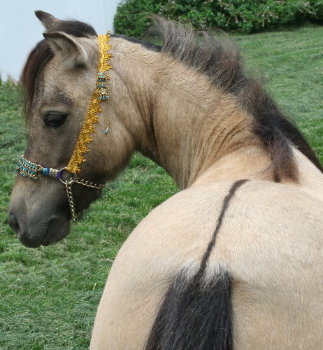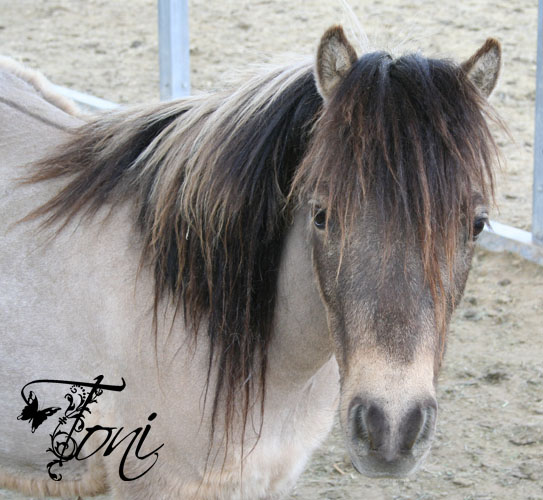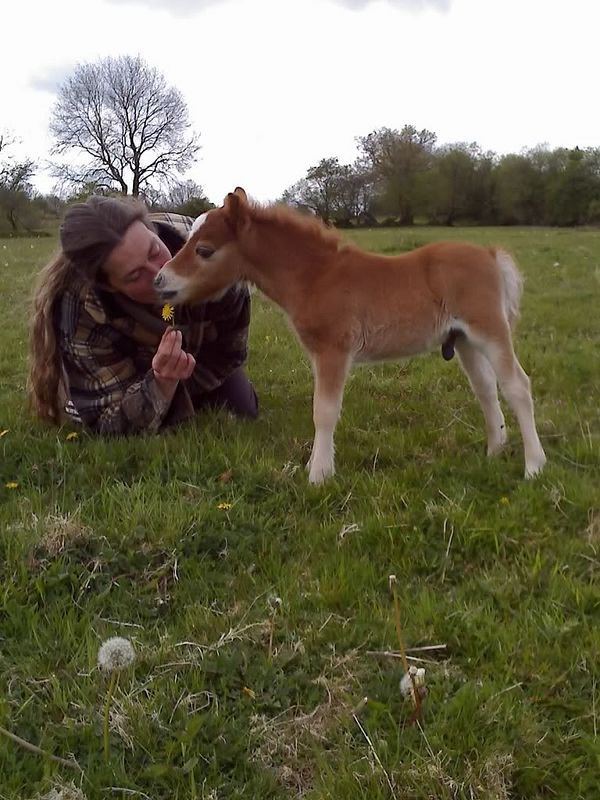You are using an out of date browser. It may not display this or other websites correctly.
You should upgrade or use an alternative browser.
You should upgrade or use an alternative browser.
dunskins
- Thread starter SampleMM
- Start date

Help Support Miniature Horse Talk Forums:
This site may earn a commission from merchant affiliate
links, including eBay, Amazon, and others.
love_casper
Well-Known Member
I do I do I do!!!
She's not a mini, but I love showing her off.

This is Xena - my BLM Mustang buckskin dun.


She's not a mini, but I love showing her off.
This is Xena - my BLM Mustang buckskin dun.


PaintNminis
Well-Known Member
I have a Dunskin Too

Here's "Starlet"
OLD STAGE BIT OF VEGAS IN THE BUFF
2007 AMHA/AMHR Buckskin Dun 31.25"


Here's "Starlet"
OLD STAGE BIT OF VEGAS IN THE BUFF
2007 AMHA/AMHR Buckskin Dun 31.25"


Lovely pictures of beautiful horses - I love that colour too. But may I ask what the difference is between a 'straight' dun and a dunskin. From the pictures, I see horses of the colour I would simply call dun - I'm not very good with all these different colours so interested for any info.
Anna
Anna

$164.99
Equitem Black Leather Miniature Pony Driving Show Training Cart Harness with Red Trim
Horse-N-Pony Depot

$32.95
Star Point Horsemanship Mini-Pony 4 Knotted Rope Halter & 8' Lead Set (Teal, Small 28-32" Mini)
Star Point Horsemanship, LLC

$3.00
HOW TO CARE FOR MINIATURE DONKEYS: A detailed guide, simplified to give your best care to a Miniature donkey
Amazon.com Services LLC

$8.88
$11.99
Mattel Spirit Untamed Mini Playset with Small Character Figure, Horse & 3 Accessories, Festival Theme with Surprise Unboxing (Styles May Vary)
Ninety6 Collective

$14.79 ($14.79 / Count)
100% Pure Wool, Cut to Fit, Natural Felt Insoles for Men, Women, Children, 12x 12 x 1/4 inch
Desert Breeze Distributing

$13.99 ($13.99 / Count)
SM Leather Short Nail Black Belted Sexy Fun Whip Flirting Fantasy Sex Toys Fetish Hand Paddle Kinky Restraint Bondage Sex Role Play
Colourful wind

$9.99
$10.99
BONSNY Enamel Metal Horse Key chains For Women Girls Gifts Car Purse Animal Pendant Charms toy (Green)
Bonsny Jewelry

$18.99
Redecker Horsehair Miniature Hand Brush with Oiled Beechwood Handle, Extra-Small Design, 8-1/4-Inches
MT BAKER MERCANTILE

$24.95
Miniature Horse 4 Knotted Training Rope Halter (Teal, Large 38-42" Pony)
Star Point Horsemanship, LLC

$6.00 ($6.00 / Count)
Sushi Ear Pick 10 Type mimikaki with Mini Sushi Replica on end. (Horse Mackerel)
GOOD CHOICE TOKYO
Thanks everybody for sharing your beautiful horses with me. I just love a dunskin, weird name and all. Yes, they are a buckskin so they have a cream gene but genetically they are also a dun which gives them a dorsal strip, and sometimes leg stripes and primitive markings by their withers and of course their mane's and tails are a different color than their bodies. I probably didn't explain that very well, but it's early here and also the last day of school. HOORRRAAY!!!!!!

 :charge
:charge

Ok you have the excuse that it was early in the morning when you posted (happy holidays by the way) and I have the excuse that I have been mare watching for the whole of May (and still am) so suffering from sleep deprivation, BUT let me see if I have this right!
A buckskin is dun coloured but without the dorsal stripe - still has black legs, mane and tail? It carries the cream gene.
A dun (not talking about blue duns or grullos) is the same colour but has the dorsal stripe and possibly leg barring etc. No cream gene.
Both can have mixed hairs in their manes and tails (similar to the Fjords?)
So a dunskin is different how? Can you tell by simply looking at them? Am I correct in thinking it is a dun with a dorsal but also carries the cream gene?
So I might have a dunskin? Sire is red dun (chestnut with strong dorsal and throws normal duns) Dam is cream. Offspring is pale dun with dark points and dark dorsal. I say 'might' as I have not colour tested her and am not bothered, just interested. Picture of her below with her first foal - chestnut, but now going very cream around muzzle, eyes, tummy and down his backside! Pictures taken on cell phone in barn just after his birth.


Colt at 10 days - his cream areas have spread more now his a month old - will he go cream do you think? His sire is my little American import Dragon, so whats the betting this colt will prove to be LWO+? LOL!!

Anna
A buckskin is dun coloured but without the dorsal stripe - still has black legs, mane and tail? It carries the cream gene.
A dun (not talking about blue duns or grullos) is the same colour but has the dorsal stripe and possibly leg barring etc. No cream gene.
Both can have mixed hairs in their manes and tails (similar to the Fjords?)
So a dunskin is different how? Can you tell by simply looking at them? Am I correct in thinking it is a dun with a dorsal but also carries the cream gene?
So I might have a dunskin? Sire is red dun (chestnut with strong dorsal and throws normal duns) Dam is cream. Offspring is pale dun with dark points and dark dorsal. I say 'might' as I have not colour tested her and am not bothered, just interested. Picture of her below with her first foal - chestnut, but now going very cream around muzzle, eyes, tummy and down his backside! Pictures taken on cell phone in barn just after his birth.


Colt at 10 days - his cream areas have spread more now his a month old - will he go cream do you think? His sire is my little American import Dragon, so whats the betting this colt will prove to be LWO+? LOL!!

Anna
love_casper
Well-Known Member
Dun and cream are 2 separate genes. Dun is NOT a color, neither is cream. They are modifiers on top of whatever base color/other modifiers the horse carries. So there is no such thing as "plain dun colored" ... it is their color + dun. Black + dun = grulla. Some say dun is a dilution because it does lighten the body color, leaving the head and legs dark. Others say it isn't because it adds dark stripes. Either way the head remains the base color, so do the legs, and then it adds the dark dorsals and leg stripes. Bay + dun is Bay Dun. The head usually stays dark bay colored, the body is lightened to aaalmost a buckskin shade, and then there's the stripes. Sorrel + dun = Red Dun.
Then when you have the cream dilution in there too, you get Buckskin Duns (dunskin) and Palomino Duns (I think some call that dunalino.) I think all the ridiculous terms of blue dun/lobo dun/dunalino simply confuse people, which is why I typicall just say base + modifier. So a red based horse with both cream and dun gets you palomino dun. A black base with both would be smokey black grulla, but since cream barely affects black they tend to look like normal grullas. And a bay base (black + agouti really ) with both cream and dun gets you Buckskin Dun.
Then of course double dilutes can carry it but it will rarely ever be noticable.
Usually it's pretty easy to tell by looking the difference between a bay dun and buckskin dun, bays tend to be more reddish throughout the body with darker heads, but when in doubt test for cream.
I'm in the process of making a web page with all of this info on it, and was making serious progress last week, until my computer with all the info on it crashed 4 times, went to the computer doctor, and still isn't feeling well lol! Once I get the darn thing to load pages without refreshing it 5 times first, I will finish it!
Then when you have the cream dilution in there too, you get Buckskin Duns (dunskin) and Palomino Duns (I think some call that dunalino.) I think all the ridiculous terms of blue dun/lobo dun/dunalino simply confuse people, which is why I typicall just say base + modifier. So a red based horse with both cream and dun gets you palomino dun. A black base with both would be smokey black grulla, but since cream barely affects black they tend to look like normal grullas. And a bay base (black + agouti really ) with both cream and dun gets you Buckskin Dun.
Then of course double dilutes can carry it but it will rarely ever be noticable.
Usually it's pretty easy to tell by looking the difference between a bay dun and buckskin dun, bays tend to be more reddish throughout the body with darker heads, but when in doubt test for cream.
I'm in the process of making a web page with all of this info on it, and was making serious progress last week, until my computer with all the info on it crashed 4 times, went to the computer doctor, and still isn't feeling well lol! Once I get the darn thing to load pages without refreshing it 5 times first, I will finish it!
Hey Alex - thanks for all that info. Have to say I'm still pretty cofused, but that's probably due to old age! Think I'll just say that I love that colour in a horse!
Hope your computer behaves itself as I would be interested in that web page when you eventually get it finished

Anna
Hope your computer behaves itself as I would be interested in that web page when you eventually get it finished
Anna
Similar threads
Accessories For Sale
Tough1 Miniature Horse Nylon Training Caveson FOR SALE $15
- Replies
- 0
- Views
- 184













































